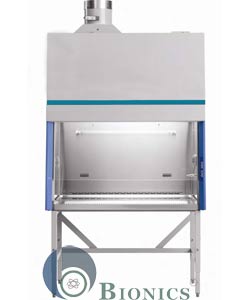Class 2 Biosafety Cabinets: Essential Equipment for Laboratory Safety and Microbiological Containment

In today’s scientific and clinical labs, safety for personnel and samples is non-negotiable. Whether it's handling live pathogens or sensitive diagnostics, biosafety cabinets form the backbone of contamination control.
Among the available options, Class 2 Biosafety Cabinets stand out for their balanced protection. These units are crucial for working with moderate-risk organisms and sensitive samples.
Biosafety Cabinets – How They Work and Why They Matter
Biosafety cabinets are ventilated enclosures built to protect both users and biological materials. They use high-efficiency filters to purify air entering and leaving the cabinet.
These units are generally classified into three categories—Class I, Class II, and Class III. Among these, Class 2 cabinets are the most versatile and commonly used.
Why Class II Cabinets Are the Preferred Choice in Labs
Class 2 Biosafety Cabinets offer simultaneous protection for people, processes, and surroundings. They direct filtered airflow in a laminar pattern over the work surface.
Both incoming and outgoing air are HEPA-filtered to maintain sterility and prevent leaks. These cabinets are frequently used in labs handling infectious agents or clinical samples.
What Makes Class 2 Cabinets Effective in Labs
A Class 2 microbiological safety cabinet includes several advanced features such as:
• Medical-grade filters for capturing contaminants
• Steady air movement to reduce airborne particle circulation
• Inward airflow to keep aerosols contained
• Built-in UV sterilisation for decontaminating surfaces
• Low sound emissions to reduce fatigue
• Clear front panel for visibility and safety
These elements ensure safety, comfort, and efficiency in day-to-day lab tasks.
Where Class 2 Cabinets Are Used
Class 2 Biosafety Cabinets are commonly used across microbiology, biotechnology, diagnostics, and pharma. They are ideal for safe handling of samples during testing and experimentation.
Whether in hospitals or drug manufacturing, these units are essential for clean procedures.
Why Laboratories Prefer Class II Safety Cabinets
Using Class 2 cabinets offers multiple advantages including operator protection and experimental reliability:
• Prevents contamination during sensitive procedures
• Acts as a barrier between user and biohazard
• Improves environmental safety by filtering outgoing air
These cabinets help labs meet safety regulations while maintaining workflow.
Regulatory Standards for Class 2 Cabinets
Top manufacturers design units compliant with major biosafety regulations worldwide. Class 2 units are sub-classified as A1, A2, B1, and B2—based on varying airflow balance and ducting needs.
• Type A2: Ideal for general-purpose labs
• Type B2: Used for hazardous vapors and chemicals
Choosing the correct subtype is vital for achieving optimal safety and functionality.
Choosing the Right Biosafety Cabinet
Before purchasing, consider:
• Your application type (e.g., diagnostics, pharma, research)
• Cabinet dimensions, ducting needs, and room layout
• Energy consumption and maintenance frequency
• Warranty, training, and certification services
Working with reliable manufacturers provides peace of mind and technical guidance.
Best Practices for Using Class II Biosafety Cabinets
For optimal results:
• Minimise airflow interference during operation
• Ensure annual certification and airflow testing
• Train users microbiological safety cabinet in proper techniques and precautions
Operational best practices include:
• Maintain biosafety gear protocols
• Minimise hand movements inside the cabinet
• Clean all contact points post-operation
• Treat UV usage as an overnight sterilisation method
Conclusion
Class 2 biosafety cabinets are essential for labs that value safety, precision, and cleanliness. They safeguard both research outcomes and operator health.
From clinical research to vaccine development, Class II cabinets maintain sterility in sensitive procedures. When investing in a biosafety cabinet, prioritise compliance, usability, and long-term support—because safe science starts with smart containment.